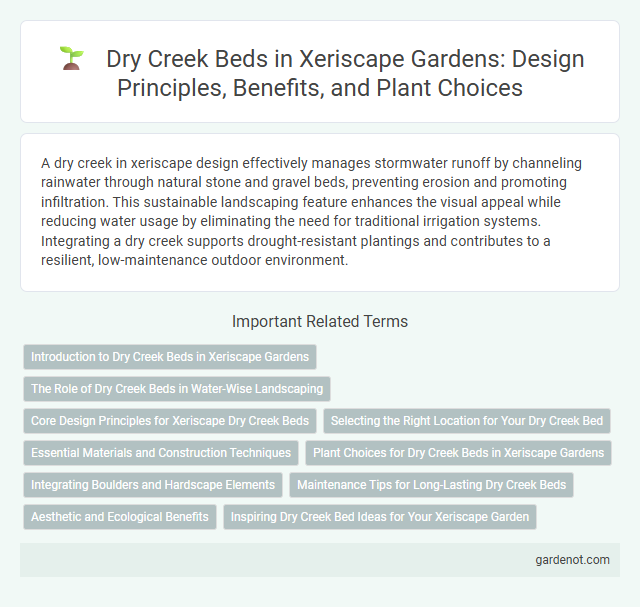A dry creek in xeriscape design effectively manages stormwater runoff by channeling rainwater through natural stone and gravel beds, preventing erosion and promoting infiltration. This sustainable landscaping feature enhances the visual appeal while reducing water usage by eliminating the need for traditional irrigation systems. Integrating a dry creek supports drought-resistant plantings and contributes to a resilient, low-maintenance outdoor environment.
Introduction to Dry Creek Beds in Xeriscape Gardens
Dry creek beds in xeriscape gardens replicate natural waterways to manage stormwater runoff effectively while enhancing landscape aesthetics. These features utilize native drought-tolerant rocks and plants to create permeable channels that reduce erosion and promote groundwater recharge. Incorporating dry creek beds supports sustainable water conservation strategies essential for arid and semi-arid environments.
The Role of Dry Creek Beds in Water-Wise Landscaping
Dry creek beds play a crucial role in water-wise landscaping by efficiently managing stormwater runoff and preventing soil erosion. These engineered channels mimic natural waterways, directing excess water to drainage areas while allowing slow infiltration into the soil, which conserves water and reduces the need for irrigation. Integrating dry creek beds into xeriscape designs enhances landscape sustainability by promoting groundwater recharge and supporting drought-tolerant plantings.
Core Design Principles for Xeriscape Dry Creek Beds
Xeriscape dry creek beds emphasize efficient water management through strategic grading and selection of native, drought-tolerant plants that minimize irrigation needs. The core design principles include proper soil preparation to enhance permeability, use of mulches and rocks to reduce evaporation, and contouring the bed to direct runoff effectively. Incorporating these elements creates sustainable landscapes that conserve water while preventing erosion and supporting local ecosystems.
Selecting the Right Location for Your Dry Creek Bed
Selecting the right location for your dry creek bed involves identifying areas with proper drainage and natural water flow on your property. Positioning it along existing slopes or low-lying spots helps channel rainwater efficiently, preventing erosion and pooling. Avoid placing the dry creek bed near foundations or utilities to minimize structural risks and ensure optimal functionality.
Essential Materials and Construction Techniques
Dry creek beds require essential materials such as gravel, river rocks, and sand to create effective drainage and aesthetic flow. Construction techniques involve excavating a shallow trench, layering landscape fabric to prevent weed growth, and strategically placing rocks to simulate natural water movement. Proper grading ensures water is directed away from structures while enhancing soil erosion control in xeriscaped gardens.
Plant Choices for Dry Creek Beds in Xeriscape Gardens
Selecting drought-tolerant plants such as sedum, yarrow, and lavender enhances dry creek beds in xeriscape gardens by reducing water consumption while adding texture and color. Native grasses like blue grama and buffalo grass stabilize soil and create natural movement in the landscape. Incorporating succulents like agave and echeveria optimizes water efficiency and thrives in arid conditions, promoting sustainable gardening practices.
Integrating Boulders and Hardscape Elements
Integrating boulders and hardscape elements within a dry creek enhances both functionality and aesthetic appeal, creating natural water flow channels resistant to erosion in xeriscape landscapes. Strategically placed boulders act as focal points and provide structural stability while complementing drought-tolerant plantings and gravel beds. This approach reduces water usage and soil displacement, ensuring sustainable landscape design in arid environments.
Maintenance Tips for Long-Lasting Dry Creek Beds
Regularly remove debris and sediment from dry creek beds to prevent clogging and maintain proper water flow. Use native, drought-tolerant plants with deep root systems along the creek edges to stabilize soil and reduce erosion. Periodic inspections after heavy rains help identify and repair any displacement or damage to rocks and liners, ensuring long-lasting functionality.
Aesthetic and Ecological Benefits
Dry creeks enhance xeriscape designs by creating visually appealing, natural-looking pathways that mimic the flow of water while remaining drought-tolerant. These features improve local ecology by providing habitats for beneficial insects and facilitating water infiltration to reduce erosion and runoff. Integrating dry creek beds supports sustainable landscaping efforts through both aesthetic charm and environmental functionality.
Inspiring Dry Creek Bed Ideas for Your Xeriscape Garden
Incorporating a dry creek bed in your xeriscape garden creates a natural drainage solution that mimics the look of flowing water without waste. Use smooth river rocks, native drought-tolerant plants like succulents and ornamental grasses, and strategically placed boulders to enhance texture and visual interest. This design not only conserves water but also adds an inviting focal point that blends seamlessly with arid landscape themes.
Dry creek Infographic

 gardenot.com
gardenot.com